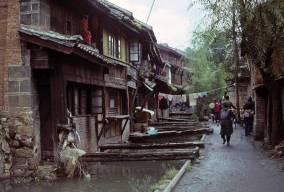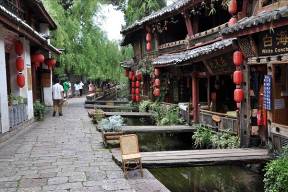 Study Tour in Sichuan and Yunan
Study Tour in Sichuan and Yunan |
|
|
In Lijiang, the UNESCO site boundary encompasses the entire old town center of Dayan, along with Shuhe and Baisha, two outlying villages on the way to Jade Dragon Snow Mountain. Heritage in Dayan old town has been defined in an especially tangible – specifically, architectural – way, leaving intangible heritage significantly less recognized and protected. This is in some respects an outcome of the 1996 earthquake, which somewhat ironically provided the city with an opportunity to rebuild according to more rigorously traditional construction techniques than those that actually characterized the city up to that point. At the same time, reconstruction was closely integrated with a strong drive to cater to a burgeoning domestic tourist market, and in a short time nearly all the old town center was occupied by non-locally owned businesses catering to tourists. The indigenous Naxi population have fled from the tourist gaze, discotheques and the tourist crowds that flood the old town, and taken up residence in newer suburbs [#s?]. While the architectural regulations in Dayan have preserved much of the historic architecture, the daily life of the Naxi culture is therefore poorly represented. Most emblematic of this change is the old town’s famous system of waterways, which once consisted of a complex network of freshwater, graywater and blackwater channels; they are now uniformly clean but serve little purpose other than as scenery (compare Figure 12a and b). |
|
| Previous Next | |

